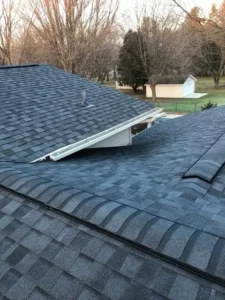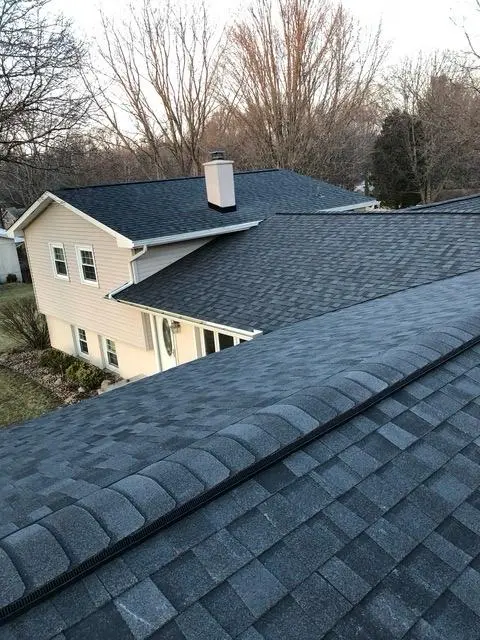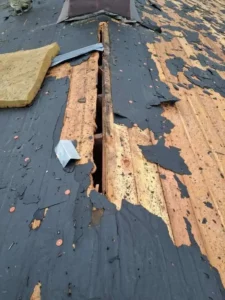As the winter season fades away, your roof may bear the brunt of the harsh weather conditions. From ice dams to heavy snow loads, various issues can emerge, compromising the structural integrity of your roof. In this blog post, we will delve into the prevalent roof problems that surface after winter and provide practical solutions to address them effectively.

Table of Contents
ToggleIce Dams and Snow Buildup
Among the top concerns post-winter are ice dams that form along the edges of roofs. These dams result from melted snow refreezing at the roof’s edge, hindering proper drainage and potentially causing water seepage under shingles, leading to damage.
To combat ice dams, it’s essential to ensure adequate attic insulation and ventilation. Maintaining a consistent roof temperature can prevent uneven snow melting and ice dam formation. Safely removing snow accumulation using a roof rake can also help prevent the formation of ice dams.
Coping with Heavy Snowfall
The weight of heavy snowfall can exert significant pressure on roofs, especially if they are not designed to withstand such loads. This strain can lead to structural damage like sagging or, in extreme cases, collapse.
To deal with heavy snowfall stress, promptly clear excess snow from your roof after a snowstorm. Using a snow shovel or roof rake, carefully remove snow to prevent overloading. Strengthening your roof structure or investing in a snow retention system can help distribute weight evenly and prevent damage.
Impact on Roof Structure
The prolonged exposure to freezing temperatures and moisture during winter can weaken the structural integrity of roofs. This can manifest as cracked or warped shingles deteriorated flashing, or compromised roof decking.
To address structural impacts, conduct a comprehensive roof inspection post-winter. Look for signs of damage such as missing or hail-damaged shingles, water stains on the ceiling, or visible wear and tear. Promptly addressing these issues through repairs or roof replacements can prevent further damage and extend your roof’s lifespan.
Addressing Leaks and Blisters
Roof leaks post-winter are often caused by the expansion and contraction of roofing materials due to temperature fluctuations. This can lead to cracks, gaps, or punctures that allow water infiltration into the roof system.
To tackle leaks and blistering, inspect your roof for water damage indicators like stains on the ceiling or damp spots in the attic. Seal any cracks or gaps with roofing cement or silicone caulk to prevent water penetration. Consider applying a waterproofing membrane or coating for added protection against future leaks.
Tackling Gutter Issues
Gutters play a vital role in directing water away from roofs and foundations. However, they are prone to clogging from debris, ice dams, or snow accumulation during winter, obstructing proper drainage and causing water pooling on the roof.
To address gutter installation complications, start by clearing debris and obstructions from gutters and downspouts. This ensures unimpeded water flow and prevents backups. Installing gutter guards or heating cables can prevent clogs and ice dams, maintaining optimal gutter function.
Ensuring Winter-Resilient Roofs
To prevent common roof problems post-winter, proactive measures are crucial to winter-proof your roof:
- Conduct regular roof inspections pre- and post-winter.
- Ensure proper attic insulation and ventilation.
- Promptly clear snow accumulation.
- Reinforce roof structures to bear heavy snow loads.
- Address leaks or damage promptly.
By following these guidelines and investing in routine roof maintenance, you can safeguard your roof’s durability through winter and beyond.
Addressing common roof issues after winter demands vigilance and proactive maintenance. By recognizing potential problems and implementing appropriate measures to mitigate risks, you can shield your roof and prolong its longevity. Remember, a well-maintained roof is vital for ensuring your home’s safety and comfort for years to come.
Read Also,
Water Damage Restoration: Quick Fixes & Long-Term
Roofing Contractor in Carmel IN: The Best Rooftop Solutions
Replace vs Repair a Roof: 7 Things to Consider Before You Decide
FAQs About Common Roof Problems
- How do ice dams form, and why are they a concern post-winter?
Ice dams form when melted snow refreezes at the roof’s edge, hindering proper drainage. They are a concern post-winter as they can lead to water seepage under shingles and cause damage to the roof structure.
- What steps can I take to prevent ice dams from forming on my roof?
Ensure proper attic insulation and ventilation to maintain a consistent roof temperature. Safely remove snow accumulation using a roof rake to prevent ice dam formation.
- Why is it essential to clear excess snow from my roof after a snowstorm?
Clearing excess snow prevents overloading on the roof, which can lead to structural damage like sagging or collapse.
- How can I strengthen my roof structure to withstand heavy snow loads?
Consider reinforcing your roof structure or investing in a snow retention system to distribute weight evenly and prevent damage from heavy snowfall.
- What are the signs of structural damage to my roof post-winter?
Look for cracked or warped shingles, deteriorated flashing, or compromised roof decking as indicators of structural damage post-winter.
- How can I address roof leaks and blistering caused by temperature fluctuations?
Inspect your roof for water damage indicators like stains on the ceiling and seal any cracks or gaps with roofing cement or silicone caulk to prevent water infiltration.
- Why are gutters prone to clogging during winter, and how can I prevent it?
Gutters can clog from debris, ice dams, or snow accumulation during winter, obstructing proper drainage. Clear debris from gutters and downspouts and consider installing gutter guards or heating cables.
- What are some proactive measures to winter-proof my roof?
Conduct regular roof inspections pre- and post-winter, ensure proper attic insulation and ventilation, promptly clear snow accumulation, reinforce roof structures, and address leaks or damage promptly.
- How often should I schedule a roof inspection post-winter?
It is recommended to schedule a comprehensive roof inspection post-winter to assess any damage caused by the harsh weather conditions.
- Why is routine maintenance essential for prolonging my roof’s lifespan?
Routine maintenance helps identify and address issues promptly, preventing further damage and extending your roof’s longevity.






